Rural Scotland Business Panel Survey
This report presents findings from the second Rural Scotland Business Panel Survey carried out in February and March 2022.
8. Markets
Key findings
Over three quarters (79%) of businesses were importers, sourcing goods from either the rest of UK (75%) or outside the UK (35%). Around half (52% were exporters), selling to the rest of the UK (50%) or outside the UK (24%).
Almost all (98%) businesses were taking, or planning, action in relation to their markets. Most businesses (95%) were either maintaining their existing markets (87%) or expanding into new market (31%), while 11% were concentrating on fewer markets.
The most important actions for helping businesses achieve their market plans were: adapting their product or service (49%), investing in technology (41%), up-skilling or re-skilling staff (40%), collaborating (39%) and bringing in external advice and support (36%).
Around three quarters (77%) of businesses were taking actions relating to their supply chains and around half (51%) were taking actions specifically in response to supply chain challenges. The most common actions being taken were using more locally sourced supplies (48%) and using more supplies from inside the UK (47%).
Import markets
Over three quarters (79%) of businesses were importers, sourcing goods from either the rest of UK (75%) or outside the UK (35%). The majority of businesses sourced goods and materials from Scotland (88%) (Figure 8.1).
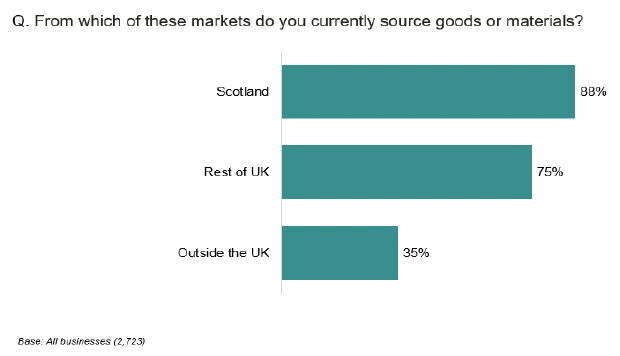
Variation in import markets
Businesses in the South of Scotland (82%) were more likely than those in the Highlands and Islands (76%) and the rest of rural Scotland (74%) to source goods from the rest of the UK.
Businesses more likely than average to source from Scotland were: food and drink (96%), tourism (92%) and remote rural businesses (92%).
Those more likely to source from both markets outside of Scotland included: large businesses (25+ staff) (88% from rest of UK, 82% from outside the UK) and businesses striving for growth (81% and 41%).
Export markets
Almost all businesses (96%) sold goods or services within Scotland, with 47% selling only within Scotland. Around half (52%) of businesses were exporters, selling to the rest of the UK (50%) and outside the UK (24%) (Figure 8.2).
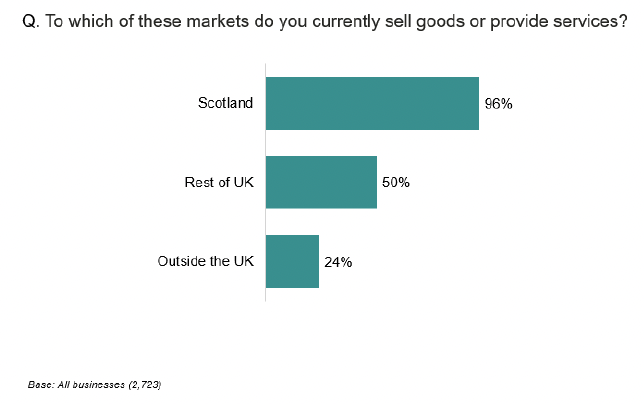
Variation in export markets
Highlands and Islands businesses were more likely to export outside the UK (31%, compared with 16% in South of Scotland, and 22% in rest of rural Scotland). South of Scotland businesses were more likely to sell to the rest of UK (64%, compared with 50% in the Highlands and Islands and 47% in rest of rural Scotland).
Certain types of business were more likely than average to sell to both markets outside of Scotland:
- Tourism – 58% to rest of UK and 44% to outside the UK.
- Creative industries – 72% and 40%.
- Financial and business services – 70% and 31%.
- Large businesses (25+ staff) – 70% and 51%.
- Businesses striving for growth – 56% and 29%.
Market activity
Almost all (98%) businesses were taking, or planning, action in relation to their markets. Most businesses (95%) were either maintaining their existing markets (87%) or expanding into new markets (31%), while 11% were concentrating on fewer markets.
Around half of businesses (51%) were responding to supply chain challenges, and a quarter (23%) were responding to changes in import arrangements[11] (Figure 8.3).
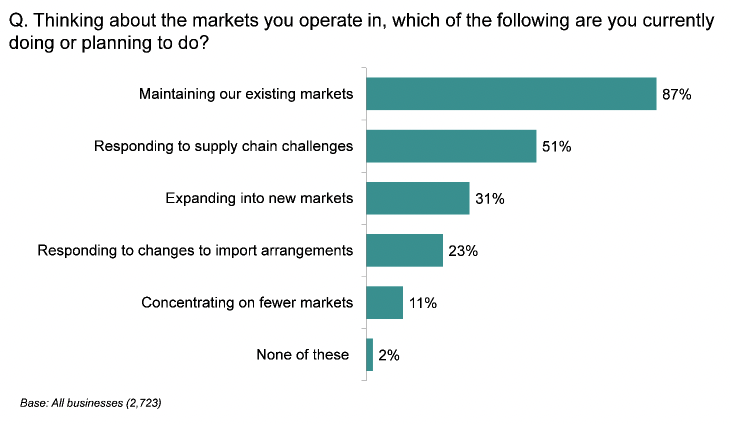
Variation in market plans
Responding to supply chain challenges was more common among businesses in the Highlands and Islands (55%) and the South of Scotland (56%) than in the rest of rural Scotland (49%).
Certain types of businesses were more likely to be taking, or planning, these actions:
- Food and drink – responding to supply chain challenges (60%) and changes to import arrangements (27%).
- Tourism – responding to supply chain challenges (58%).
- Creative industries – expanding into new markets (41%).
- Those operating above pre-pandemic levels and those striving for growth – expanding into new markets (43% and 58% respectively).
- Those operating below pre-pandemic levels and those aiming to downsize – focusing on fewer markets (13% and 25%).
- Those importing from outside the UK – responding to supply chain challenges (65%), responding to changes to import arrangements (44%) and expanding into new markets (44%).
- Those exporting outside the UK – expanding into new markets (48%).
Supporting marketing activity
The most important actions for helping businesses achieve their market plans were: adapting their product or service (49%), investing in technology (41%), up-skilling or re-skilling existing staff (40%), collaborating (39%) and bringing in external advice and support (36%) (Figure 8.4).
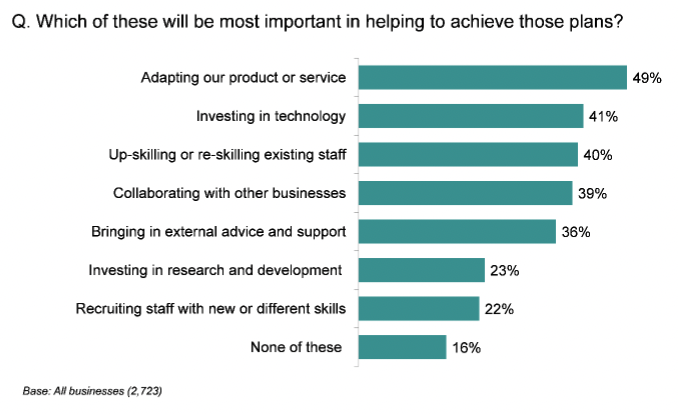
Variation in actions
Those that were expanding into new markets (in Figure 8.3) were more likely to say that the following actions were important: adapting their product or service (67% said this was important), re-skilling or up-skilling staff (56%), investing in technology (56%), investing in research and development (38%) and recruiting staff with new or different skills (34%).
Actions that were higher than average among certain sectors were:
- Food and drink – bringing in external advice and support (47%), and investing in research and development (32%).
- Tourism – adapting product or service (58%), re-skilling or up-skilling staff (46%), and recruiting staff with new or different skills (28%).
- Financial and business services – investing in technology (47%), and collaborating (46%).
- Creative industries – adapting product or service (57%), collaborating (48%), and investing in research and development (33%).
There was further variation among:
- Large businesses (25+ staff) – re-skilling or up-skilling staff (64%), investing in technology (58%), recruiting staff (43%), and investing in research and development (34%).
- Those importing from outside the UK – adapting product or service (57%), collaborating (43%), and investing in research and development (32%).
- Those exporting outside the UK – collaborating (47%), investing in technology (46%), investing in research and development (32%), and recruiting staff (26%).
- Business operating above pre-pandemic levels – using less or greener forms of transport (29%) and stockpiling (25%.
Those striving for growth were more likely to be taking each action (see Appendix A).
Supply chain actions
Around three quarters (77%) of businesses were taking action relating to their supply chains. The most common actions were using more locally sourced supplies (48%) and more supplies from inside the UK (47%) (Figure 8.5).
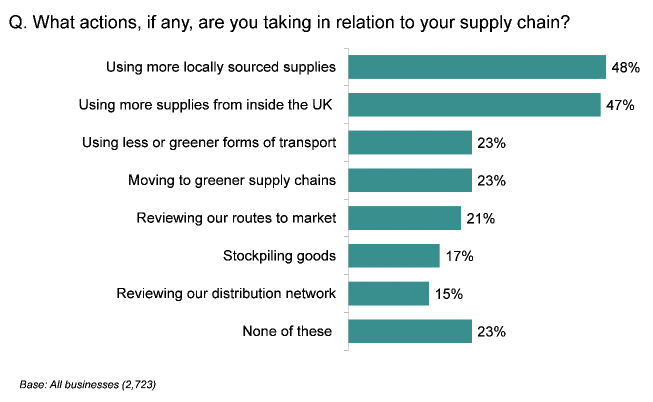
Variation in actions
Businesses in the Highlands and Islands (82%) and the South of Scotland (80%) were more likely than those in the rest of rural Scotland (75%) to be taking actions in relation to their supply chain.
Each action was more common among those that were responding to supply chain challenges (in Figure 8.3), including:
- using more supplies from inside the UK (62%),
- using more locally sourced supplies (55%),
- moving to greener supply chains (33%),
- using less or greener forms of transport (29%),
- reviewing routes to market (32%) and distribution networks (24%), and
- stockpiling (24%).
Certain actions were more common among:
- Food and drink – reviewing their routes to market (28%) and distribution network (21%).
- Tourism – using more locally sourced supplies (62%) and more suppliers from inside the UK (54%).
- Remote rural businesses – using more locally sourced supplies (54%) and stockpiling goods (21%).
- Large businesses (25+ staff) – using less or greener forms of transport (32%), reviewing routes to market (32%) and distribution network (26%) and stockpiling goods (26%).
- Those importing from outside the UK – using more suppliers from the UK (51%), using less or greener forms of transport (26%), moving to greener supply chains (28%), reviewing routes to the market (28%), reviewing distribution network (20%) and stockpiling goods (23%).
- Those exporting outside the UK – using less or greener forms of transport (27%), reviewing routes to the market (28%), and reviewing their distribution network (21%).
Contact
Email: socialresearch@gov.scot
There is a problem
Thanks for your feedback